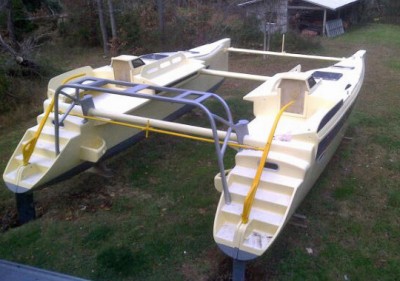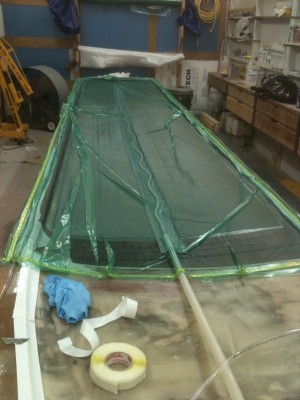I’m having a bionic eye installed on starboard side over the holidays. I will be pretty well out of it for a while but should be fully back by New Year.
All posts by kurt
Tube Cat 30
Edge Seal Roundup
There are many ways to seal the edges of a vacuum bag. A survey:
SEALANT TAPE AT200Y YELLOW from Fiberlay works very well, but is one-time only. I could never get it off the bag so the bag was damaged getting the part out.
PVC pipe snap bead. I recall seeing this in the Gougeon’s magazine. A pvc pipe is ripped and then snapped over another, with the bag plastic in between. I resisted that way as the ripping is one more job to do.
Storm Window Bead. I prefer the inexpensive storm window sealer (Frost King by Thermwell Products http://beatlas.com)1-800-299-5700. They are inexpensive, but the shipping is expensive. Maybe I should keep a few hundred here in the office to go out with the plots.
Rope Caulk. I understand some have used rope caulk, but I could never get it to work well in the cold, which is most of the year here.
Stick. Matthew Reynolds uses a stick or pvc pipe on the bag end and rolls the bag around it. He then clamps the roll off. Along the long side he uses mailing tape with good results. The bag has to be even and smooth for that.
A guy could use a few tubes of Liquid Nails each bagging, but it takes some time to squirt out.
The joints or corners on all the systems take a shot of plywood panel adhesive (Liquid Nails) to seal.
Please add any others people have used with success.
I can see a published technical paper here with the results including vacuum hold duration comparisons and cost comparisons.
Holiday Discount Sale
Again we are starting the very popular annual holiday stock plans discount sale. I think this is the 4th year of doing this at www.multihulldesigns.com. It should be up at the website today and last until January 15th. Be sure to hit refresh to clear out the old cache. As soon as I catch up here, more goodies are coming up for the blog.
Metric
Virtually all new work is done in metric now. The work is created real world size and then plotted at some scale, metric or not. However there are some exceptions. I recall that some 15 years or so ago the US Coast Guard declared that all work submitted to them for review must be in metric. Within a month or so, the plans reviewers had told me that any plans submitted in metric would be returned without any action.
So, on the chance that a plan set is different than you prefer, I propose buying a dual format tape measure and this website, http://www.hocltd.com/metricalc.html
Again, most of the new work is metric and most of it has dual dimensions.
Dr. Strange’s Board
Simo is even more famous
Simo on his amazing 24′ tri has another brush with fame.
See http://smalltrimarans.com/blog/?p=4617#more-4617
Latest
Between rush deadlines and supporting some 50 ongoing projects, the blog has fallen behind. As soon as I can surface for air, some of the topics will be:
Revisiting Post-Apocalyptic Boat Building.
Always new projects submitted.
Latest on sealing the vacuum bag.
Looking into PET foam.
The greater Seattle area has about a dozen relatively exotic KHSD multis building and sailing- lets look.
The cat projects in Africa and Estonia are ongoing.
I should catch up soon.
Pacific Marine Expo 2010
I’m off to Fish Expo today. Fortified myself with sardine lunch. They have upscaled the name to Pacific Marine Expo, http://www.pacificmarineexpo.com/10/public/enter.aspx but we still know it as Fish Expo. Its a serious boat show, especially for Alaska fishermen. I ran into Steve Sheidler there once and he put it perfectly. He said “If these guys have equipment failure, people die.”
Plywood/Glass strength Comparison
How strong is glass compared to plywood? Here is a table comparing strengths with out of plane loads (like water pressure).
Plywood/Glass Thickness Conversion comparing bending strength. (Assumed 60,000 psi bending strength for glass and 10,000 for plywood)
Assumed that triaxial amount is on both sides of a core
Ply thickness Triaxial thickness Core
3mm ply equals (12 oz) 400 gsm w/12 mm core
4mm ply equals (17 oz) 600 gsm w/12 mm core
6mm ply equals (22 oz ) 750 gsm w/12 mm core
9mm ply equals (34 oz) 1150 gsm w/19 mm core
12mm ply equals (2) (22 oz ) 1500 gsm w/19 mm core

